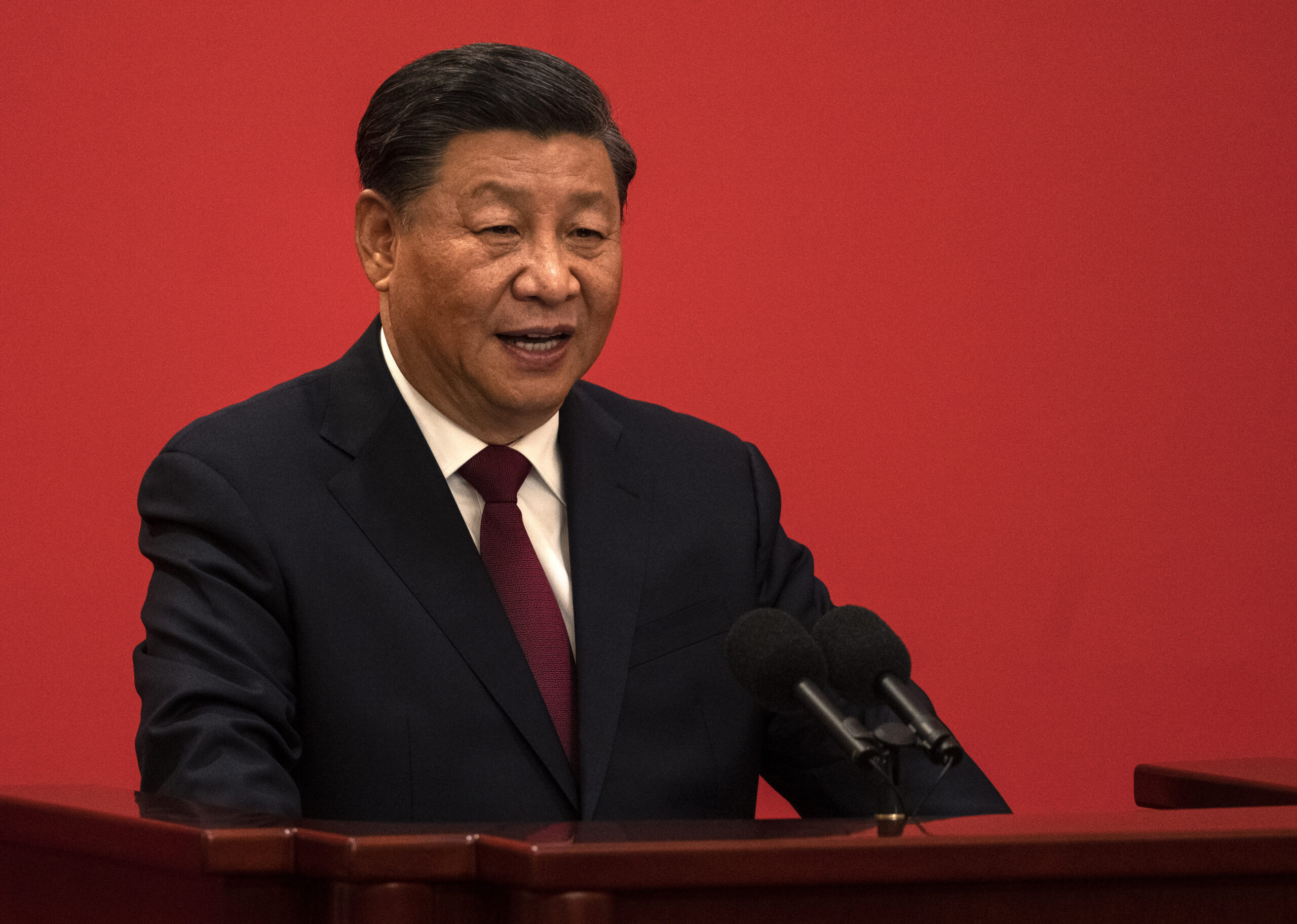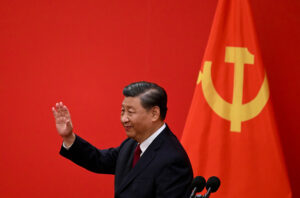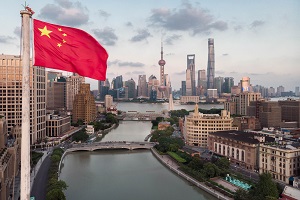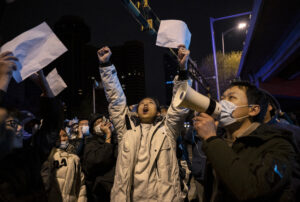
Nationwide protests against Xi Jinping’s zero-covid policy caught the Chinese Communist Party off-guard. Expect the Party’s security apparatus to strike back with quiet precision.
December 2022
In the days after November 25, protests broke out in cities across China. While local protests are not uncommon in China, these demonstrations—sparked first by an apartment fire in in Urumqi that claimed at least 10 lives and then fed by the public’s wider anger at the country’s stringent zero-covid policy—were not of the typical variety. They were large, widespread, seemingly spontaneous, and extraordinary in their demands, calling for greater personal rights and freedoms, including freedom of expression. Rarer still, some demonstrators called for Xi Jinping’s resignation and the end of Chinese Communist Party rule. For ten years, Xi has been at work building an emboldened security state. These protests put that system to the test.
In his first two terms, Xi made “national security” a centerpiece of his approach to governing. When he talks about national security, however, we should hear “regime security”: the political security that’s at the heart of his national security concept is defined, clearly, as safeguarding “the party’s leadership, China’s socialist system, and the authority of the Central Committee with Xi Jinping as the core.” To achieve this goal, Xi directed officials to focus on “prevention and control,” signifying a more proactive, preventive approach than the “stability maintenance” of his predecessor, Hu Jintao.
This isn’t sloganeering. During his first two terms, Xi’s promulgation of the comprehensive national-security concept (zongti guojia anquanguan) resulted in a transformation of China’s domestic security bureaucracy and national-security laws, and the replacement of key personnel across the military and political-legal apparatus. It also produced marked increases in social control and repression in Tibet, Xinjiang, and Hong Kong: all border areas where Xi views the risk of external forces destabilizing China internally as particularly high. In Xinjiang in particular, the drive to preventively “immunize” Uyghurs from ideas that the authorities consider politically threatening has resulted in an intensely repressive campaign of mass internment and coercive re-education, deemed genocide by two successive U.S. administrations. And the party-state’s official directive in 2015 to construct a “multi-dimensional information-based prevention and control system for public-social security” has resulted in the rise of a surveillance state unprecedented in its scope and intensity.
The Twentieth Party Congress in October 2022 appeared to cement Xi’s approach to security. In its work report, national security was—for the first time—broken out as a separate section. The contents of that section, however, were phrasings that have been used in previous media commentaries and official documents over the course of the past ten years, suggesting that we should read the Twentieth Party Congress both as codifying current security practices and as elevating and locking in Xi’s approach as formal party-state doctrine.
Then came November’s zero-covid protests. While protest over local issues is a common occurrence in Chinese politics, several features of this wave of protests made them unusually troubling for Beijing. The party-state has long sought to prevent unrest from spreading across localities; in 2019, Chen Yixin—then the secretary-general of the Central Political-Legal Committee and now also minister of state security—said that localities should consolidate governance at the local level so that “small issues don’t leave the village; big issues don’t leave the township.”
In addition to preventing geographic contagion, Beijing has also sought to atomize grievances to prevent mobilization and collective action that cut across different classes and sectors of Chinese society, as well as across ethnic groups. However, the party’s rigid and costly zero-covid policies, and the arbitrary use of state power to enforce them, has inadvertently done the opposite: providing a unifying grievance around which vigils could coalesce and turn into protests. After years of official media presenting Uyghur dissatisfaction as a violent threat to China’s Han-majority citizenry, the solidarity that Chinese citizens have expressed with the victims of the apartment building fire in Xinjiang has been significant—and likely concerning to the CCP. Finally, the transnational dimension of the protests has been notable, especially in the context of Xi’s exhortation of diasporic responsibility toward party-state goals and securitization of the Chinese diaspora—including, at times, through outright transnational repression. All these are notable features of this wave of protest in China, and not welcome ones for the leaders sitting in Zhongnanhai.
China’s management of the covid pandemic is the unsurprising but costly result of a decision to treat a sustained public health challenge as a public security crisis: Much of China’s pandemic-related spending went toward enhancing social control and enforcement capabilities for lockdowns and quarantines, rather than toward boosting mass vaccination and medical treatment capacity. The presence and specific features of these protests—and the fact that they appear to have temporarily overwhelmed China’s censorship system—represent multiple points of localized failure in the “prevention” component of national security emphasized by Xi.
Despite appearing to have been caught off-guard, however, the Chinese security system recalibrated quickly. Official pronouncements blamed local implementation for problems with the zero-covid policies—a time-honored tactic that shifts blame off the most senior officials (and that might well pave the way for a renewed round of purges in the public-security forces at the provincial and local levels in coming months). Beijing also made concessions: The National Health Commission announced that it would move to relax many of the most restrictive measures that had generated public anger. China also appears to be gearing up for a renewed push for mass vaccination.
Meanwhile, senior officials have signaled that tolerance of organized dissent will remain low. Chen Wenqing, chair of the Central Political-Legal Commission that oversees China’s domestic security apparatus, called a meeting in which he emphasized the need to resolutely safeguard national security and social stability, “crack down on infiltration and sabotage by hostile forces,” and “resolutely crack down on illegal/criminal acts that disrupt social order.” Coming out of the Twentieth Party Congress, there is also no sign of the kind of internal elite split that complicated the CCP’s response to the 1989 Tiananmen Square protests, a prospect that has worried Chinese leaders ever since.
And while China’s security state did not prevent these protests from emerging, it has since swung into action to deter participants and prevent continued mobilization. To deter vigils and protests, some demonstration sites have been physically blocked, while a heavy police presence has surrounded others. In some places, police have checked cellphones to see if their owners had Virtual Private Networks (VPNs) or other apps that could be used to communicate and coordinate gatherings. Other protest participants reported getting phone calls from local police asking about their participation and warning them about their behavior.
Meanwhile, the Cyberspace Administration of China issued new guidance to tech companies to restrict the use of VPNs and constrain the circulation of protest-related content on social media—a key step in the party-state’s efforts to forestall collective action. It also appears to have mobilized online commentators to flood social-media platforms with pornography and spam posts to crowd out posts about the demonstrations, a distraction technique previously documented by researchers as part of the digital toolkit used to head off organized dissent.
The emergence of protest should not itself be a surprise. In authoritarian political systems, the public’s apparent mood or attitude often masks genuine underlying resentment, and large-scale protests can therefore cascade in ways that catch authorities by surprise. The latest round of protests in China is no exception.
Even if China’s surveillance systems and police forces could not prevent protests from emerging, however, those same capabilities are already proving useful in the next stage of the party-state’s response. If recent patterns hold, authorities will leverage the local party-state’s surveillance tools and overall informational capacity to identify demonstrators, and to determine the best strategy for demobilizing them. If citizens’ grievances can be mollified with low-cost material concessions, local authorities may then grant them, especially in light of the relaxation of many of the most stringent anti-covid controls and the authorities’ directives to use a “people-centered approach” to “help resolve the practical difficulties of the masses.”
If low-cost concessions are not sufficient, then the state can use its information advantages in a “relational repression” strategy—that is, to make threats via neighbors, coworkers, or family members—or simply to detain and punish protesters outright. (Organizers, in particular, are likely to be preemptively detained the next time there is an event that could mobilize the citizenry.) Local authorities use such targeted and private approaches, which often are coercive and heavy-handed, to atomize and disaggregate protest movements, thereby lowering the risk of backlash and simultaneously allowing the state to portray itself positively in official media and other public fora. Executing these strategies successfully requires a lot of information, but that is exactly the capability that China’s subnational authorities have spent a decade trying to build.
The party-state has an added reason to show that it can capably and successfully manage this wave of protests. In the past five or so years, the People’s Republic of China has begun to portray itself as a supplier of global security, particularly in the realm of policing and law enforcement; officials sometimes refer to “telling the story of ‘Safe China.’” China markets its exports of surveillance technology as tools to help other countries control violent crime and enhance public safety. Moreover, Beijing presents its offers of international police cooperation—as with the recent proposal to train 2,000 police under the Global Security Initiative in Xi Jinping’s speech to the Shanghai Cooperation Organization this fall—as a form of security cooperation and capacity building that will address common non-traditional security threats. These efforts seek to position China as a “security partner of choice” for other countries, but one that offers internal security assistance, not military aid.
The global appeal of China’s tools, however—whether these are police tactics or surveillance technology platforms—depends largely on how effective its approach appears to be at home. This global dimension is probably not a central factor in Beijing’s calculus, but it may be an added consideration.
Protest is, by its nature, visible and observable to outsiders. Repression, on the other hand, is often hidden and discreet—and successful repression is especially likely to be so. A visible crackdown in the streets, Tiananmen-style, is something the CCP has long worked to avoid. Any retribution against protest organizers, leaders, or participants is likely to take place where outside observers cannot see, and China’s complex surveillance capabilities are likely to target those who engaged in opposition activity, or those the party-state expects may do so next time. The world witnessed the protests; it is not as likely to witness the response.![]()
Sheena Chestnut Greitens is associate professor at the University of Texas at Austin, and a Jeane Kirkpatrick visiting fellow at the American Enterprise Institute. She is currently writing a book on China’s approach to national security.
More from the Journal of Democracy:
 |
 |
 |
|
For Xi Jinping, the Economy Is No Longer the Priority By Guoguang Wu |
China: Totalitarianism’s Long Shadow By Minxin Pei |
Breaking Out of Xi’s Great Prison By Guoguang Wu |
Copyright © 2022 National Endowment for Democracy
Image Credit: Kevin Frayer/Getty Images
